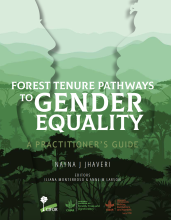Land Library Search
Through our robust search engine, you can search for any item of the over 73,000 highly curated resources in the Land Library.
If you would like to find an overview of what is possible, feel free to peruse the Search Guide.
/ library resources
Showing items 1 through 9 of 90.Strong evidence indicates that the Brazilian government is taking advantage of the confusion caused by the Covid-19 pandemic to speed-up a wide-ranging environmental setback.
This practitioner’s guide explains how to promote gender-responsive forest tenure reform in community-based forest regimes. It is aimed at those taking up this challenge in developing countries.
Migration connects land use in areas of origin with areas of new residence, impacting both through individual, gendered choices on the use of land, labor, and knowledge.
The Nationally Determined Contributions (NDCs) of several non-Annex I countries mention agroforestry but mostly without associated mitigation target. The absence of reliable data, including on existing agroforestry practices and their carbon storage, partially constrains the target setting.
In recent decades in northwest Vietnam, Arabica coffee has been grown on sloping land in intensive, full sun monocultures that are not sustainable in the long term and have negative environmental impacts.
The 2019 fire crisis in Amazonia dominated global news and triggered fundamental questions about the possible causes behind it. Here we performed an in-depth investigation of the drivers of active fire anomalies in the Brazilian Amazon biome.
With 15–20% of Indonesian oil palms located, without a legal basis and permits, within the forest zone (‘Kawasan hutan’), international concerns regarding deforestation affect the totality of Indonesian palm oil export.
Land use and climate change are recognized as two major drivers affecting surface streamflow. On the Chinese Loess Plateau, implementation of several land restoration projects has changed land cover in recent decades.
Did you know that forests cover nearly 1/3 of land globally?
That’s 4.06 billion hectares.
In other words, there is around 0.52 ha of forest for every person on the planet.



